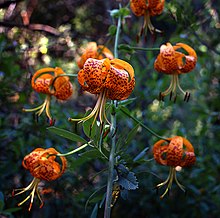Lilium pardalinum
| Lilium pardalinum | |
|---|---|

| |
| Scientific classification | |
| Kingdom: | |
| (unranked): | |
| (unranked): | |
| Order: | |
| Family: | |
| Genus: | |
| Species: | L. pardalinum
|
| Binomial name | |
| Lilium pardalinum | |
| Synonyms[1] | |
|
Synonymy
| |

Lilium pardalinum, also known as the leopard lily or panther lily, is a flowering bulbous perennial plant in the lily family, native to Oregon, California, and Baja California.[1] It usually grows in damp areas. Its range includes California chaparral and woodlands habitats and the Sierra Nevada.[2][3]
Typically L. pardalinum grows to about 2 metres (6.6 ft) high; the tallest and most vigorous plants can reach up to 2.5 metres (8.2 ft). The bulbs are small, and many are usually clustered together on a rhizomatous stock. The flowers are Turk's-cap shaped, red-orange, with numerous brown spots, usually flowering in July.
- Lilium pardalinum subsp. pardalinum Kellogg -- leopard lily - southern California, Baja California
- Lilium pardalinum subsp. pitkinense (Beane & Vollmer) Skinner -- Pitkin Marsh lily - northwestern California
- Lilium pardalinum subsp. shastense (Eastw.) Skinner -- Shasta lily - Oregon, northern California
- Lilium pardalinum subsp. vollmeri (Eastw.) Skinner -- Vollmer's lily - southwestern Oregon, northwestern California
- Lilium pardalinum subsp. wigginsii (Beane & Vollmer) Skinner -- Wiggins' lily - southwestern Oregon, northwestern California
The subspecies Pitkin Marsh lily, Lilium pardalinum subsp. pitkinense, is federally listed as an endangered species.
Cultivation
L. pardalinum is cultivated by specialty plant nurseries as an ornamental plant, for use in native plant gardens and wildlife gardening; as well as providing height and colour in the flower border and for cut flowers.
References
External links
 Media related to Lilium pardalinum at Wikimedia Commons
Media related to Lilium pardalinum at Wikimedia Commons Data related to Lilium pardalinum at Wikispecies
Data related to Lilium pardalinum at Wikispecies- Jepson Manual Treatment: Lilium pardalinum
- USDA Plants Profile: Lilium pardalinum (leopard lily)
- Labs1.eol.org
- Lilium
- Flora of California
- Flora of Oregon
- Flora of the Cascade Range
- Flora of the Great Basin
- Flora of the Klamath Mountains
- Flora of the Sierra Nevada (U.S.)
- Natural history of the California chaparral and woodlands
- Natural history of the California Coast Ranges
- Natural history of the Central Valley (California)
- Natural history of the Channel Islands of California
- Natural history of the Peninsular Ranges
- Natural history of the San Francisco Bay Area
- Natural history of the Santa Monica Mountains
- Natural history of the Transverse Ranges
- Garden plants of North America
- Liliales stubs
